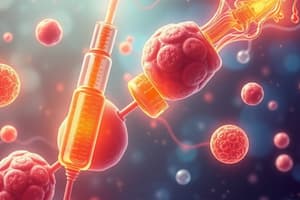Podcast
Questions and Answers
What is the primary effect of glucagon on glycogen metabolism?
What is the primary effect of glucagon on glycogen metabolism?
- No effect on glycogen metabolism
- Increases glycogen synthesis
- Increases glycogen breakdown (correct)
- Decreases glycogen breakdown
Which hormone has the primary target of muscle tissue?
Which hormone has the primary target of muscle tissue?
- Glucagon
- Epinephrine
- Insulin (correct)
- None of the above
How does insulin affect the level of Fructose-2,6-bisphosphate in muscle tissue?
How does insulin affect the level of Fructose-2,6-bisphosphate in muscle tissue?
- Increases only in liver tissue
- No effect on the level
- Decreases the level
- Increases the level (correct)
Which hormone primarily increases cyclic-AMP levels in the body?
Which hormone primarily increases cyclic-AMP levels in the body?
What is the effect of epinephrine on gluconeogenesis?
What is the effect of epinephrine on gluconeogenesis?
Flashcards
Glucagon's effect on cyclic-AMP
Glucagon's effect on cyclic-AMP
Glucagon increases cyclic-AMP levels in the liver, stimulating processes like gluconeogenesis (new sugar synthesis) and glycogen breakdown.
Glucagon's effect on Fructose-2,6-bisphosphate
Glucagon's effect on Fructose-2,6-bisphosphate
Glucagon increases Fructose-2,6-bisphosphate levels in the liver to further encourage gluconeogenesis and glycogen breakdown
Epinephrine's effect on gluconeogenesis
Epinephrine's effect on gluconeogenesis
Epinephrine increases gluconeogenesis in muscle and liver, primarily targeting the muscle first.
Insulin's effect on cyclic-AMP
Insulin's effect on cyclic-AMP
Signup and view all the flashcards
Insulin's effect on Fructose-2,6-bisphosphate
Insulin's effect on Fructose-2,6-bisphosphate
Signup and view all the flashcards
Source of Glucagon
Source of Glucagon
Signup and view all the flashcards
Source of Epinephrine
Source of Epinephrine
Signup and view all the flashcards
Source of Insulin
Source of Insulin
Signup and view all the flashcards
Primary target of Glucagon
Primary target of Glucagon
Signup and view all the flashcards
Primary target of Epinephrine
Primary target of Epinephrine
Signup and view all the flashcards
Primary target of Insulin
Primary target of Insulin
Signup and view all the flashcards
Study Notes
Effects of Hormones on Carbohydrate Metabolism
- Hormones: Glucagon, Epinephrine, Insulin
- Source of Hormones:
- Glucagon: Pancreatic α cells
- Epinephrine: Adrenal medulla
- Insulin: Pancreatic β cells
- Primary Targets:
- Glucagon: Liver
- Epinephrine: Muscle > Liver
- Insulin: Muscle, liver, adipose tissue
- Effects on Metabolic Processes:
- Cyclic AMP: Increased by Glucagon and Epinephrine
- Fructose-2,6-bisphosphate: Decreased by Glucagon and Epinephrine
- Gluconeogenesis: Increased by Glucagon and Epinephrine
- Glycogen Breakdown: Increased by Glucagon and Epinephrine, decreased by Insulin
- Specific actions in muscle: Epinephrine increases glycogen breakdown in muscle, Insulin decreases glycogen breakdown in muscle.
Studying That Suits You
Use AI to generate personalized quizzes and flashcards to suit your learning preferences.




